The 1960s was a transformative decade across the globe, marked by cultural shifts, technological advancements, and a spirit of innovation that permeated every aspect of life – including automobiles. The cars of the 60s weren’t just modes of transport; they were symbols of freedom, style, and the burgeoning muscle car era. This period gave birth to some of the most popular and recognizable vehicles in automotive history, cars that continue to captivate enthusiasts and collectors alike. Let’s take a ride through memory lane and explore some of the most quintessential and popular 60’s cars that defined a generation.
Ford Mustang
![]() Ford Mustang 1960s iconic car
Ford Mustang 1960s iconic car
Arguably the most iconic car of the 1960s, the Ford Mustang burst onto the scene in 1964 and ignited a revolution. Its long hood, short deck design, and affordable price tag made it an instant hit. Initially, the Mustang wasn’t about raw power, but it offered style and the potential for performance upgrades. The availability of a V8 engine from the start hinted at its future muscle car iterations. As the decade progressed, Ford unleashed more potent V8s and paired them with robust four-speed manual transmissions, transforming the lightweight Mustang into a thrilling driving machine. With body styles ranging from fastbacks to convertibles, the Mustang catered to a wide audience. Even the legendary Carroll Shelby got involved, creating high-performance versions that cemented the Mustang’s legendary status. The Mustang’s impact is so profound that even those outside the car world instantly recognize its silhouette.
Chevrolet Camaro
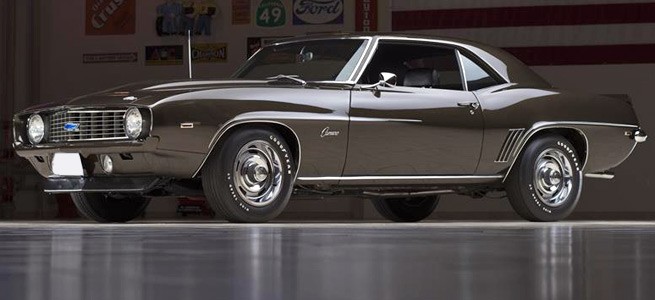 1960s Chevy Camaro 427 muscle car
1960s Chevy Camaro 427 muscle car
Chevrolet’s answer to the Mustang arrived two and a half years later, and it was worth the wait. The Chevy Camaro followed a similar formula: a rear-wheel-drive platform weighing under 3,000 lbs, a vast array of engine choices, and striking good looks. By late 1966, the muscle car craze was in full swing, and the Camaro was designed to compete head-on. From the outset, it offered big-block engine options, signaling its serious performance intentions. While it initially trailed the Mustang in sales, the first-generation Camaro has become a highly sought-after classic, often commanding top prices at auctions like Barrett-Jackson.
Chevrolet Corvette
The Corvette had already established itself as America’s sports car in the 1950s, but the C2 generation, particularly the 1963 model, is most strongly associated with the 1960s. Drawing inspiration from the stunning Mako Shark concept car, the 1963 Corvette Sting Ray was a design masterpiece. This generation marked significant advancements, including the introduction of the big-block V8 engine and independent rear suspension. These upgrades transformed the Corvette into a true sports car, offering both exhilarating performance and improved handling. While relatively accessible in its day, big-block C2 Corvettes are now highly valuable collectibles, often selling for six-figure sums.
Volkswagen Beetle
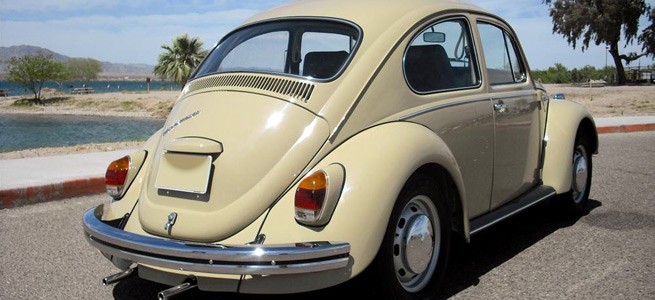 1960s Volkswagen Beetle compact car
1960s Volkswagen Beetle compact car
The Volkswagen Beetle boasts a remarkable production run from 1938 to 2003, but it was in the 1960s that it truly became a global phenomenon. The Type 1 Beetle, the most iconic version, sold over 21 million units worldwide. These air-cooled, rear-engine cars were fun to drive, affordable, and surprisingly reliable. The Beetle played a crucial role in paving the way for other German automotive brands like BMW and Mercedes-Benz in the American market. Even as the automotive landscape evolved, the original Beetle remained in production in Mexico for many years, even alongside the radically different New Beetle. In its final year, a limited run of 3,000 commemorative editions were produced, each with a modest 50 horsepower engine, a testament to its enduring appeal despite its humble performance.
Volkswagen Microbus
The Volkswagen Microbus, officially known as the Type 2, became just as much of a cultural icon as the Beetle. During the 1960s, both the T1 and the less rounded T2 generations were produced. Sharing the Beetle’s rear-mounted, air-cooled engine and rear-wheel-drive configuration, the Microbus, or “hippie van,” became synonymous with the decade’s counter-culture movement. While its high center of gravity made it less agile than the Beetle, the Microbus offered practicality and a unique charm that resonated with a generation. Despite facing import restrictions in the US in the early 1970s, the Microbus continued production in other countries until 2013, proving its lasting global appeal.
Lincoln Continental
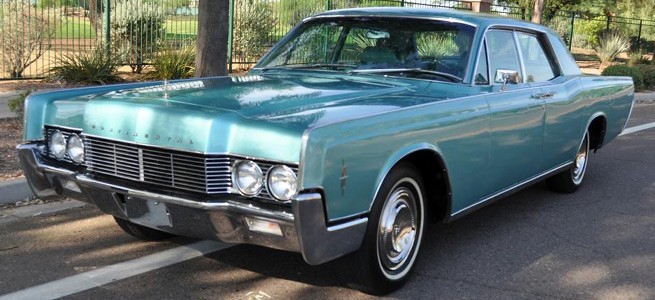 1960s Lincoln Continental luxury car
1960s Lincoln Continental luxury car
The Lincoln Continental of the 1960s, produced from 1961 to 1969, is a design landmark. Its slab-sided styling was a radical departure from the previous Mark X Continental, though both were undeniably large vehicles. A signature feature of this generation was the rear-hinged “suicide doors,” adding to its gangster-era mystique. Coupled with its luxurious interior, comfortable ride, and imposing presence, the Continental was a successful seller in the high-end car market. Tragically, it also became infamous as the car in which President John F. Kennedy was assassinated in 1963, forever associating it with a pivotal moment in American history.
Plymouth Barracuda
The Plymouth Barracuda is now renowned as a high-value muscle car at auctions, but its origins were quite modest. Launched just weeks before the Ford Mustang, the first-generation Barracuda was essentially a fastback coupe version of the Plymouth Valiant. While its front end was conventional, the rear featured a distinctive and expansive wraparound glass. The second generation, introduced in 1967, adopted a more muscular aesthetic and offered potent V8 engines, including the legendary 426 Hemi. This transformation solidified the Barracuda’s place in muscle car history.
Shelby Cobra
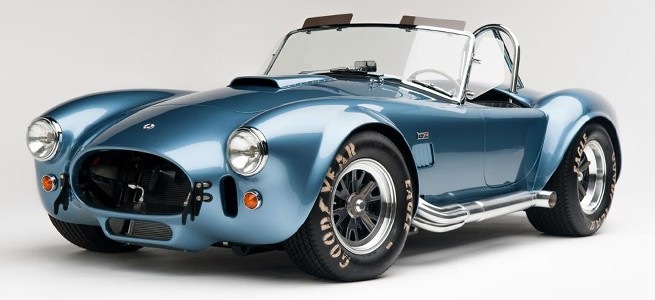 1960s Shelby Cobra 427 sports car
1960s Shelby Cobra 427 sports car
Carroll Shelby, a celebrated race car driver, aimed to create a lightweight and powerful sports car in the early 1960s. He achieved this vision by combining the British AC Ace body with a Ford-sourced V8 engine, resulting in the iconic Shelby Cobra. Sold from 1962 to 1967, the Cobra is often categorized among the ultimate muscle cars. With a weight of just over 2,000 lbs and a massive 427 V8 under the hood, the Cobra delivered blistering acceleration, reaching 0-60 mph in a mere 4.5 seconds, a figure primarily limited by traction. It became a legend both on the track and on the street.
Futura – Batmobile
The inclusion of a 1955 Lincoln concept car in a list of 1960s cars might seem unusual, but the Futura’s story took a dramatic turn in this decade. After its run on the auto show circuit, this bubble-top concept car changed hands several times and fell into disrepair. When ABC was developing the Batman TV series, they needed a distinctive Batmobile. The Futura, with its futuristic design, was chosen and quickly (and expensively) transformed into the iconic vehicle that graced television screens and became a favorite superhero ride for a generation. Pow!
Jaguar E-Type
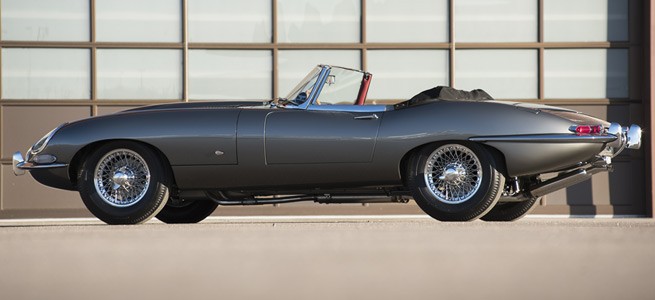 1960s Jaguar E-Type British sports car
1960s Jaguar E-Type British sports car
Produced from 1961 to 1975, the Jaguar E-Type epitomized British sports cars of the era. Universally admired for its breathtaking beauty, the E-Type is often ranked among the most beautiful cars ever designed. Built on a proper racing chassis, it offered exceptional driving dynamics. The Series 1 models featured smooth inline-six cylinder engines, though they were not known for their reliability. Despite this, the E-Type single-handedly boosted the popularity of British cars in the US, a remarkable achievement for a single model.
Ferrari 250 GTO
The Ferrari 250 GTO was the equivalent of the F40 of the 1960s – an ultra-desirable, high-performance machine. Considered one of Enzo Ferrari’s early masterpieces, the 250 GTO is also among the most beautiful cars on this list. It was powered by a 3.0-liter V12 engine producing 300 horsepower, propelling its lightweight body (under 2,000 lbs) to victory on race tracks worldwide. Originally priced around twice as much as a Corvette, it was an exotic car that delivered performance to match its stunning looks. Today, owning a 250 GTO is a dream for the ultra-wealthy; in 2013, one sold at auction for over $38 million, and current listings reach upwards of $55 million.
Ford GT40
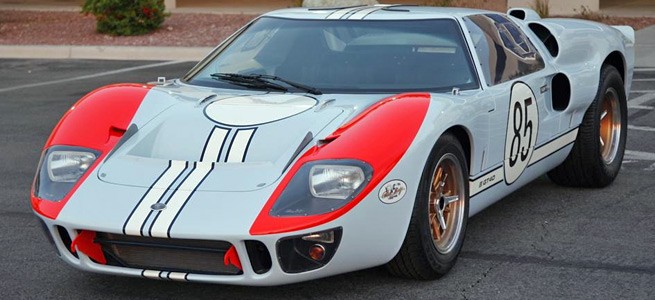 Ford GT40 supercar 1960s
Ford GT40 supercar 1960s
From 1964 to 1969, Carroll Shelby played a key role in developing Ford’s ultimate performance machine, the GT40. Henry Ford II sought to challenge Ferrari’s dominance in top-tier prototype racing. While the GT40 initially showed promise, it struggled on the track. Once Shelby took over the program, the 427 V8-powered GT40 became a dominant force. Its racing achievements were unparalleled; in one year, it swept the podium at the 24 Hours of Daytona, 12 Hours of Sebring, and the 24 Hours of Le Mans, achieving first, second, and third place in all three prestigious races.
Aston Martin DB5
The Aston Martin DB5 is arguably the quintessential grand tourer, setting the standard for all GTs that followed. Even upon its debut in 1963, it exuded an air of exclusivity and expense. Many consider its styling as refined and beautiful as the iconic Mercedes-Benz Gullwing. The DB5 offered ample power from its smooth 4.0-liter inline-six engine, paired with a sophisticated ZF 5-speed transmission – a feature remarkably advanced for its time, predating widespread 5-speed availability by two decades. Its timeless design, muscular yet elegant, still influences modern Aston Martin models today. This enduring appeal is why it became James Bond’s vehicle of choice, and a dream car for many.
Chevrolet Chevelle
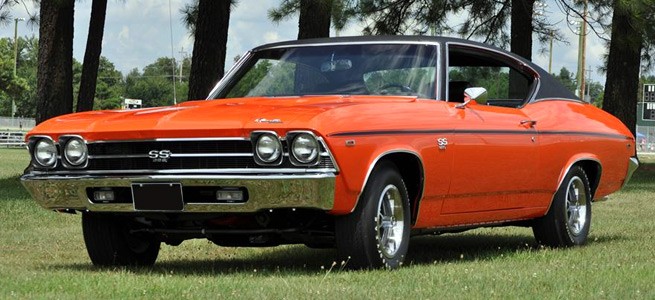 1960s Chevy Chevelle muscle car
1960s Chevy Chevelle muscle car
The Chevrolet Chevelle consistently ranks high on muscle car lists. While its exact placement is debatable, its legendary status as one of the best muscle cars of the era is undeniable. The Chevelle reached its performance peak in 1970 with the 450 hp LS6 SS, but the 1960s versions were certainly no slouches. The 1964 debut model, with a 220 hp V8, was just the beginning. Once Pontiac unleashed the GTO, Chevrolet responded swiftly. By mid-year, the 327 V8 was added, and by 1966, the 396 V8, producing well over 350 hp, became available, escalating the muscle car arms race.
Pontiac GTO
Speaking of the GTO, Pontiac’s groundbreaking model ignited the muscle car wars. Facing a ban on factory-backed racing, Pontiac’s engineers sought to inject excitement into their lineup. Another restriction limited mid-size cars to mid-size engines (330 ci or less), but Pontiac cleverly circumvented this by offering the GTO as an option package for the Tempest model. This “option” included a potent 325 hp 389 V8 engine. Outpowering its rivals by a significant margin, the GTO instantly became a pop culture icon and launched the muscle car phenomenon that defined the late 60s.
Lamborghini Miura
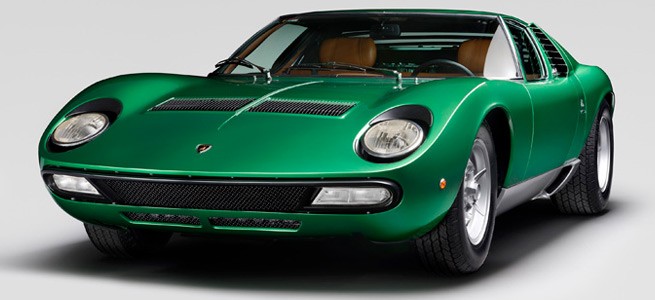 1960s Lamborghini Miura supercar
1960s Lamborghini Miura supercar
The Lamborghini Miura is an icon of automotive design and innovation. Surprisingly, Ferruccio Lamborghini, the company’s founder, was not initially enthusiastic about it. He preferred luxurious GT cars like Lamborghini’s earlier 350GT and 400GT. The Miura was a radical departure, featuring sleek, race car-inspired lines and a groundbreaking mid-engine layout. Upon its debut in 1966, its 3.9-liter V12 engine produced an impressive 350 hp, and its aerodynamic body allowed it to claim the title of the fastest production car in the world.
Chevrolet Impala
The 1961 Chevrolet Impala ushered in a new era of full-size Chevy styling for the decade, characterized by cleaner, more streamlined lines. The third-generation Impala continued to offer Chevrolet’s largest engines, including the legendary 409 V8, immortalized in the Beach Boys’ song. It wasn’t just its size that made the 409 Impala impressive; its output of one horsepower per cubic inch transformed it into a formidable drag strip contender. The Impala’s expansive fenders and trunk also made it a favorite among lowrider enthusiasts, providing ample space for air bags and hydraulics.
Porsche 911
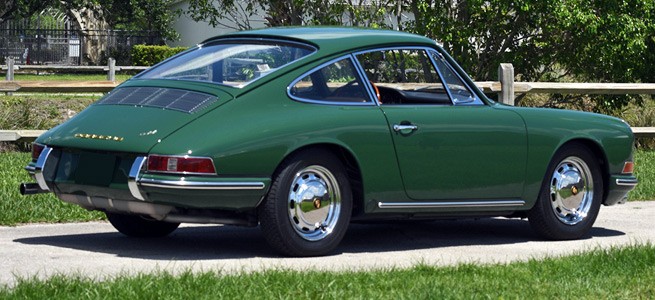 1960s Porsche 911 sports car
1960s Porsche 911 sports car
Ferdinand Porsche sought to create a larger, more powerful successor to his first model, the 356. The result was the 911, an automotive legend that would outlive its creator. The 1964 Porsche 911 was not a powerhouse with its 128 hp flat-six cylinder engine, but it possessed exceptional beauty and handling dynamics right from the start. The infamous Porsche options list began in the 60s, offering features like targa tops and even gasoline-burning cabin heaters. While turbocharging wouldn’t arrive until the 1970s, the 911’s journey to becoming a performance icon began in the 60s.
Toyota 2000GT
Japan’s first collectible car, the Toyota 2000GT, started as a show car in 1965. Its overwhelmingly positive reception led to production in 1967. While its 2.0-liter inline-six engine was less powerful than other GTs of the era, its exceptional handling allowed it to outperform many more powerful cars on the track, earning it a dedicated following and numerous race victories. Its “coke bottle” styling is considered among the most beautiful ever created, and it was even featured as James Bond’s car in You Only Live Twice.
Lotus Elan
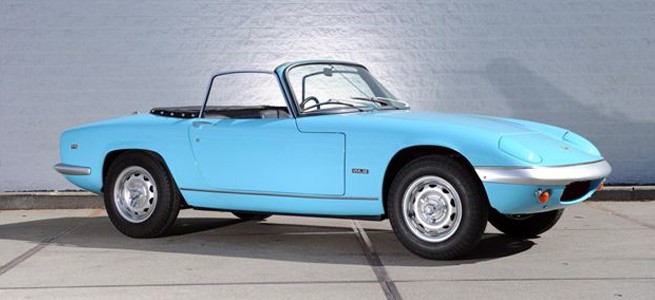 1960s Lotus Elan British roadster
1960s Lotus Elan British roadster
Looking at a 1960s Lotus Elan, one might mistake it for a 1990s Mazda Miata. The Lotus design was ahead of its time, while the Mazda was a deliberate retro design, making the Elan look contemporary even today. The Elan was a pure sports car, initially offered only as a two-seat roadster. With just 108 hp at launch, the Elan relied on its incredibly light weight and superb handling to deliver an engaging driving experience. Its minimalist and curvaceous design was widely admired. The Elan became a minor legend, enhancing Lotus’s global reputation.
Buick Riviera
In the early 1960s, Buick needed a personal luxury car to compete with the highly successful Ford Thunderbird. Inspired by a custom Rolls-Royce, Buick’s design chief, Bill Mitchell, envisioned a sharp-edged design for GM. After some refinements, the 1963 Riviera debuted to critical acclaim and strong sales. Its combination of sharp, angular lines and emerging muscular styling resulted in what many consider the most beautiful Buick ever created. Later versions offered increased performance, but the first-generation GS models represent the pinnacle of GM design in the 1960s.
Shelby Daytona Coupe
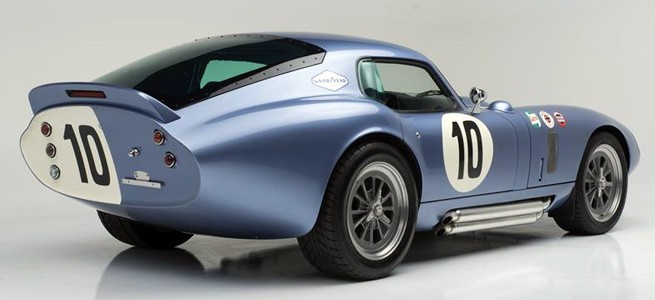 1960s Shelby Daytona Coupe race car
1960s Shelby Daytona Coupe race car
The Shelby Cobra was designed to challenge Ferrari on high-speed race circuits. However, Shelby realized that the Cobra’s open cockpit limited its top speed to around 160 mph. Using a damaged Cobra chassis, the stunning bodywork of the first Daytona Coupe was hand-fabricated. With a top speed of 190 mph, the Daytona Coupe achieved numerous class wins and set 25 speed records at Bonneville, proving its aerodynamic superiority.
Studebaker Avanti
Studebaker was facing financial difficulties in the late 1950s, and the Avanti was conceived as a halo car to revitalize sales. The Avanti was a fiberglass-bodied sports car, similar to the Corvette, powered exclusively by a robust V8 engine. Despite its attractive design and focus on safety, the Avanti sold fewer than 2,000 units in its first year. Sales improved slightly the following year, but not enough to rescue the company. Production ceased in December 1963 when Studebaker’s plant closed. While Studebaker eventually faded away, the Avanti nameplate retains a unique presence in automotive history.
Chevrolet Corvair
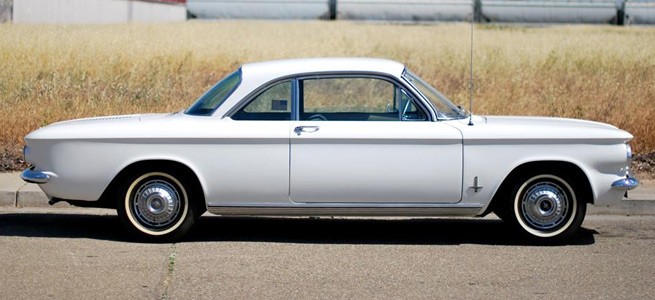 1960s Chevy Corvair rear-engine car
1960s Chevy Corvair rear-engine car
The Chevrolet Corvair, with its sealed, Tesla-like grille, was a departure from conventional American car design. Uniquely for GM and its American competitors, the Corvair was rear-engined, similar to the Porsche 911. Initially intended to compete with compact cars like the VW Beetle and Ford Falcon, the Corvair adopted a relatively conventional 2-door, 4-seater styling. Introduced in 1960 with a starting price under $2,000, the Corvair evolved significantly over the years. However, American drivers were unfamiliar with rear-engine handling characteristics, and the Corvair unfairly gained a reputation as unsafe, partly fueled by Ralph Nader’s book “Unsafe at Any Speed.”
Jensen Interceptor
The Jensen Interceptor can be described as a Ferrari GTC4Lusso with a distinctly 70s aesthetic. Jensen, a British car manufacturer known for its distinctive rear window designs, launched the Interceptor in 1966. With its long hood and bubble-like rear window, it had a unique and instantly recognizable appearance. While its reliability was questionable, it delivered impressive performance thanks to Chrysler V8 engines, including the powerful 440 cubic inch unit. Just over 6,000 Interceptors were produced before Jensen closed in 1976. However, the Interceptor’s enduring coolness has led to plans for a modern revival.
These are just some of the most quintessential and popular cars from the 1960s. The decade was a golden age for automotive design and innovation, leaving behind a legacy of vehicles that continue to inspire and excite car enthusiasts today. Do you agree with this list? Are there any other iconic 60’s cars you think should be included? Let us know in the comments!